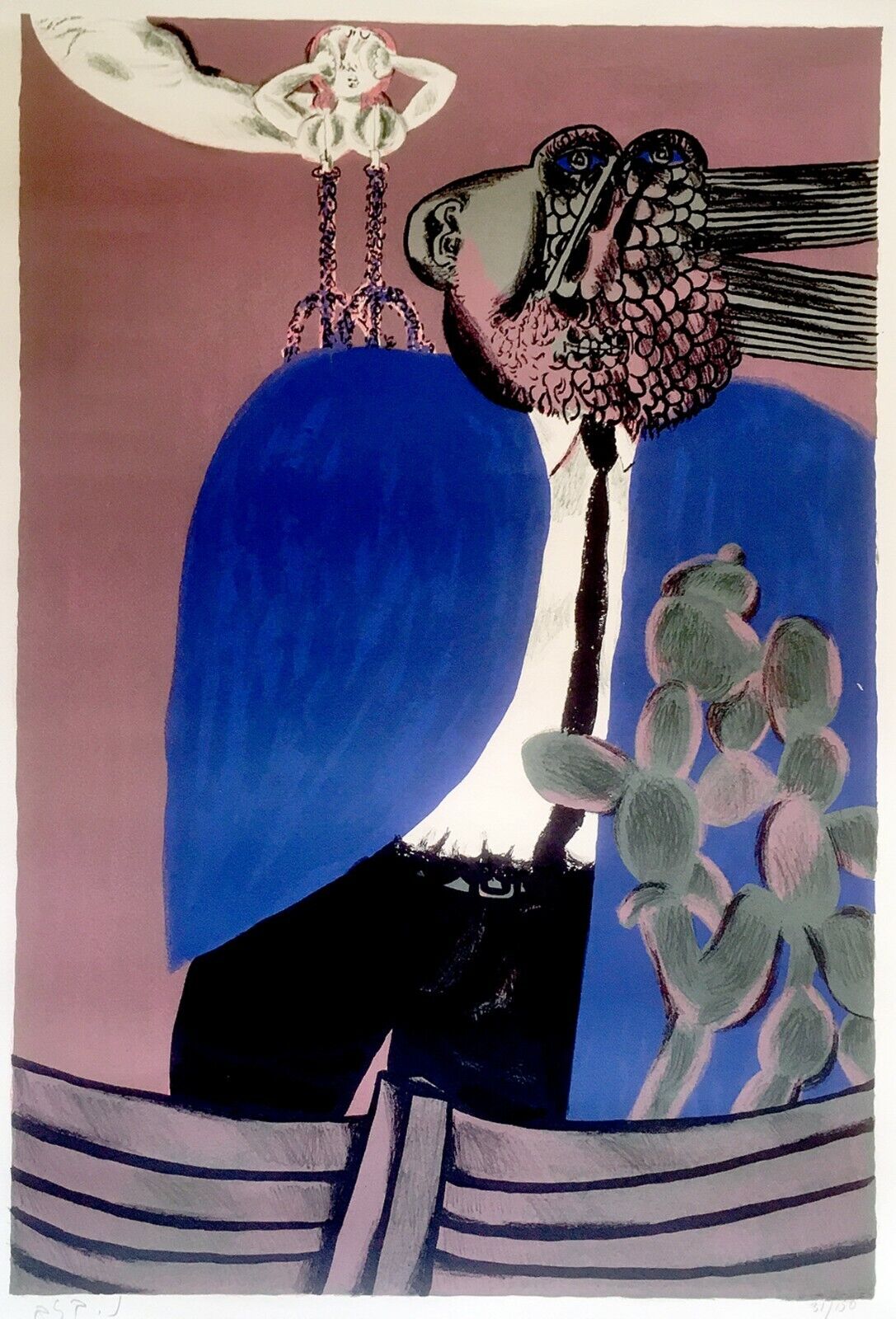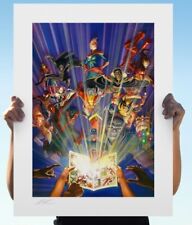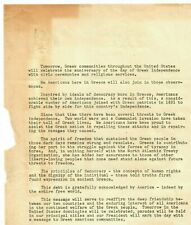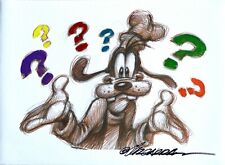HAND SIGNED Jewish ORIGINAL BEZEM ART LITHOGRAPH Israel MOURLOT Judaica HEBREW For Sale

When you click on links to various merchants on this site and make a purchase, this can result in this site earning a commission. Affiliate programs and affiliations include, but are not limited to, the eBay Partner Network.
HAND SIGNED Jewish ORIGINAL BEZEM ART LITHOGRAPH Israel MOURLOT Judaica HEBREW:
$175.00
DESCRIPTION : Up for sale is a BEAUTIFUL Judaica JEWISH ISRAELI ART PIECE by the BEZALEL ARTIST , Pupil of Mordecai Ardon,The HOLOCAUST SURVIVOR of German descent NAFTALI BEZEM, Being a colorful FINE STONE LITHOGRAPH which is HAND SIGNED with pencil and numbered 31/150 . The STONE LITHOGRAPH was printed by MOURLOT - PARIS which guarantees its FINE QUALITY and ORIGINALITY. Unframed.SIZE around 28x 20 \" ( Not accurate ). Excellent quality heavy & thickpaper.Excellent condition.( Pls look at scan for accurate ASIS images ) Will be sent inside a protective rigid packaging.PAYMENTS : Payment method accepted : Paypal& All credit cards.SHIPPMENT :SHIPP worldwide via registered airmail is $ 25 . Will be sent inside a protective rigid packaging. Will be sent around 5-10 days after payment .
Naftali Bezem (Hebrew: נפתלי בזם; born 1924) is an Israeli painter, muralist, andsculptor Biography Bezem who was born in Essen, Germany, in 1924. His earlyadolescence was spent under Nazi oppression, in constant fear for the safety ofhis parents, who perished in Auschwitz concentration camp. Naftali emigrated toMandate Palestine in 1939, at the age of fourteen with a Youth Aliyah group.From 1943 to 1946, he studied art at the Bezalel Academy of Art and Design inJerusalem with Israeli painter Mordecai Ardon. He then spent three years studyingin Paris. His most famous public works include a wall relief at Yad Vashem inJerusalem and the ceiling mural in the main reception room at the President\'sResidence, Jerusalem. Awards In 1957, Bezem was a co-recipient of the DizengoffPrize for Painting.References (inHebrew). Tel Aviv Municipality. reading Debel Gallery ein Kerem, NaftaliBezem, Jerusalem, Debel Gallery ein Kerem, 1980. Gross, Ted W.,Ben-Dov and I. Mintzer, The Passover Haggadah Illustrated by Naftali Bezem,Tel Aviv, 1982. Kohn, Matthias, Naftali Bezem, Bern, BenteliVerlag, 1998. Open Museum, Naftali Bezem - Rope Ladder 1996-1999, OpenMuseum, 2000. Born in Essen, Germany. studied at Bezalel Academywith and in Art Catholic School. Bezem was born in Essen, the youngest ofthree sons of an orthodox Jewish family who had immigrated there from Poland.His father worked in the annex of the main synagogue frequented by polishimmigrants. Just before the outbreak of world war two, Naftali, aged fourteen,was sent by his parents to Israel. They themselves died in Auschwitz camps.This personal history largely shaped Bezem\'s artistic style and work.Bezem is best known for his symbolic rendering of the holocaust and the returnto the land of Israel. He is an artist who continually reacts to his times andhas developed thematically and stylistically as these times and his resultantmessage changed. Bezem formulated his own allegorical form system,emotionally nourished by the inner Jewish religious experience and his visibletokens. His paintings tend to the monumental and decorative, with the resultthat Bezem has become one of the most popular muralist in Israel. Bezemviewed art as an expression of the soul, it’s heritage, and it’s truth.He won several prestigious prizes, and has been shown internationally in groupand solo exhibitions, including the Venice Biennale and the São Paulo Biennale.Bezem art remains a reflection not only of his own life, but of that of manyIsraelis. He was conscious of this in his social realist days when he paintedworkers and kibbutzniks, the ma\'abarah and the war of independence, and equallyso in his symbolist period, when he dealt with the holocaust and immigration.Bibliography Ziva Amishai- Maisles, The Unknown Bezem ,Naftalie Bezem,Sifriat Poalim, 1986. Naftali Bezem- Rope Ladder 1996-1999, The Open Museum,Industrial Parks Tefen and Omer Born in Essen, Germany, in 1924, NaftaliBezem emigrated to Palestine in 1939 under the auspices of Youth Aliyah. Hestudied for three years at the Bezalel School of Art in Jerusalem, and latertaught there. From 1949 to 1951 he painted in Paris. Bezem\'s first majorshowing was of drawings in the Venice Biennale of 1954, where six years laterhe exhibited five paintings. In 1960 his work was included in the \"Noir etBlanc\" exhibition in Lugano; in 1963 the Sao Paulo Bienal and the GalerieCharpentier in Paris. His paintings were also exhibited in the Art Israelexhibit organized by the Museum of Modern Art in New York. In 1964 an exhibitof his works was held in New York and at Brandeis University. In Israel, Bezemwon the Dizengoff Prize of 1957; and in 1967 won a grant from the governmentwhich permitted him six months\' painting in Paris at the Israel studio of theCite Internationale des Arts. His works were exhibited at the National Museumin Jerusalem in 1959, Tel Aviv Museum in 1960, Haifa Museum in 1964. Bezem hasexecuted a number of important commissions as well, including murals for theIsrael Pavilions at the Brussels World\'s Fair and at Expo\'67, a sculptural wallfor the El-Al Airlines Building in Tel Aviv, and murals for the Zim Steamship\"Theodore Hertzl\" and for the Weizmann Institute in Rehovot. **** Bezalel Academy of Arts and Design is Israel\'snational school of art, founded in 1906 by Boris Schatz. It is named for theBiblical figure Bezalel, son of Uri (Hebrew: who was appointed by Moses to oversee the design andconstruction of the Tabernacle (Exodus 35:30). The Bezalel School was foundedin 1906 by Boris Schatz. Theodor Herzl and the early Zionists believed in thecreation of a national style of art blending classical Jewish/Middle Easternand European traditions. The teachers of Bezalel developed a distinctive schoolof art, known as the Bezalel school, which portrayed Biblical and Zionistsubjects in a style influenced by the European jugendstil (art nouveau) andtraditional Persian and Syrian art. The artists blended \"varied strandsof surroundings, tradition and innovation,\" in paintings and craftobjects that invokes \"biblical themes, Islamic design and Europeantraditions,\" in their effort to \"carve out a distinctive styleof Jewish art\" for the new nation they intended to build in theancient Jewish homeland. TheBezalel School produced decorative art objects in a wide range of media:silver, leather, wood, brass and fabric. While the artists and designers wereWestern-trained, the craftsmen were often members of the Yemenite Jewishcommunity, which has a long tradition of working in precious metals. Silver andgoldsmithing had been traditional Jewish occupations in Yemen. Yemeniteimmigrants were also frequent subjects of Bezalel school artists. Leadingartists of the school include Meir Gur Aryeh, Ze\'ev Raban, Shmuel Ben David, Ya\'ackovBen-Dov, Ze\'ev Ben-Tzvi, Jacob Eisenberg, Jacob Pins, Jacob Steinhardt, andHermann Struck In 1912, the school had only one female student, Marousia(Miriam) Nissenholtz, who used the pseudonym Chad Gadya.The school closed downin 1929 in the wake of economic difficulties, but reopened in 1935, attractingmany teachers and students from Germany, many of them from the Bauhaus schoolshut down by the Nazis ****Naftali Bezem – Art with an AgendaByAngela LevineJanuary 8, 201317784viewsShare on FacebookTweet on Twitter‘Coming Home’ should be the title of Naftali Bezem’s major retrospective. Not just because this artist, now 86 years old, returned to this country in 2009 after 15 years self -imposed exile in Europe, but because he has come home in a deeper sense. After years of frustration and disappointment, the art establishment now seems ready to offer Bezem a solid place in the history of Israeli art. What was the situation before? From the 1940s onwards, Israel’s mainstream artists adopted international- abstract art to the exclusion of all other trends. Figurative painting like Bezem’s was considered obsolete. In addition, they scorned Bezem’s unswerving intent to produce art with a Jewish, historical or social agenda. This exhibition – the opening attended by more than 900 people – proves that the judgment of the art establishment was seriously flawed.Out of scores of paintings and drawings that Bezem has produced in the last 60 years, either in Israel or Europe, curator Ruthi Ofek has made a clever, tight selection that showcases the best of Bezem. Included are several iconic pieces that have not been exhibited in public for years. The works are grouped around three major themes: social criticism of life in Israel, the family of the artist, individual and collective memories of the Holocaust, and Bezem’s key motif – The Boat.Bezem’s life story is integral to understanding his art. He was born in Essen, Germany, into an orthodox family who had emigrated from Poland. But in 1938, his family were expelled from the country and forced into a refugee camp. At the age of 14, just days before the outbreak of World War II, his parents succeeded in sending him to Palestine under the auspices ofAliyat Han’oar(Youth Immigration). For years, Bezem lived in constant fear for the safety of his parents, eventually learning that they had perished in Auschwitz. He was left alone with his memories.In the mid 1940s, he studied at the Bezalel School of Arts and Crafts in Jerusalem where one of his teachers was the extraordinary Jewish symbolist painter Mordechai Ardon. Imbued with the ideals ofHaShomer HaTzair, a Socialist-Zionist youth movement, Bezem saw his future as an artist with a social agenda. Believing that mural painting was the best way forward, he left for Paris to study in a Catholic school that specialized in teaching wall painting techniques. In1951 he returned to Israel with his wife Hannah and infant son Yitzhak, and became an illustrator and art teacher for the Kibbutz movement.The Madonna of the Ma’abara, (transit camp) 1952, oil and pencil on Masonite panel, Azrieli Group CollectionPresented under the titleWe Have Come to Build – and to be Built in Return(a phrase taken from a pioneer song) are examples of Bezem’s work from the 1950s in a social realist style. These include charcoal drawings and paintings documenting life in the transit camps set up after the war. Eye-catching, in particular, are a bird’s eye view, in jewel-like colors, of the geometric layout of a camp; and a touching portrait titledThe Madonna of the Ma’abarashowing a young woman, eyes lowered, feeding her baby in the shelter of a tin shack.To the Aid of the Seaman, 1952, oil on plywood panel, Courtesy of Yad Ya’ari Center, Givat HavivaTo the Aid of the Seamen(1952) Bezem’s best known social realist painting created a public uproar when it was first exhibited. The artist was berated for daring to criticize a government decision to end a seamen’s strike through the use of force. In this picture, which derived inspiration from Italian and Mexican mural painting, strongly modeled figures are set against flat areas of color. Depicted is the moment when laborers and kibbutzniks are leaving to join the strikers, who are seen in the distances, flags flying, marching beyond a cluster of tents.Amongst paintings that take the Bezem family as their theme, there are many realistic examples: portraits of his parents (as he remembered them), a study of his wife reading and sketches of his two sons. In general, Bezem treats the Holocaust largely through symbols, but some paintings, likeMass Graveshowing a religious Jew digging his own tomb, are shockingly realistic. But progressing through the exhibition one notes that from 1960 onwards Bezem abandoned realism and overt social criticism. Instead, he opted to paint mysterious scenes in which the objects are amorphous, suggesting rather than defining their identity. Or else, he created well-planned surreal compositions in which his personal lexicon of symbols relating to Jewish and personal history, emigration and settlement, are clearly stated and intertwined.The Set Table, 1960, oil on Masonite panel, collection Haifa Museum of ArtThe Table (1960) is a fine example of one of his dream-like paintings. It is part of a group, the latest completed only a few months ago, that relates to Bezem’s memories of the last Shabbat spent in his parents’ home. In this particular work it looks as if a softly colored veil has been drawn across the scene, blurring many details. Clearly shown is a woman (Bezem’s mother), dressed in blue, standing beside a table filled with an assortments of objects which are not identifiable, save for a pair of a candlesticks, and the body of a rooster – a sacrificial symbol. To the left Bezem has painted in an upright ladder, his personal symbol for Aliyah; while on the right is a cactus plant, symbol of new beginnings in the Land of Israel. High up, perhaps heralding a brighter future, a hand stretches out to touch a deep-red sun..Lion Gate, 1975, oil on canvas, private collection, Tel AvivLion Gate, conceived mainly in a palette of grays, deep blues and purples, is a striking example of those paintings in which Bezem presents his signature motifs with clarity, even though the overall meaning is often beyond one’s grasp. In the upper far corner, small white figures are grouped at the entrance to what appears to be a gas chamber. Below, is the nude body of a woman, representing the Universal Mother. In her hands she clutches candlesticks in the shape of plowshares, one is unlit in memory of Bezem’s son Yitzhak who died in 1975 in a terrorist attack. To complete this composition, in which past and future are welded together, a warrior like figure clings to a circular ladder, and another set of candles sprout from the head of the Lion of Judah – Bezem’s symbol for a survivor.Boat, 2012, painted wood, photo taken in the artist’s Jaffa studio (all photo credits: Abraham Hay)Just visible at the top of theLion Gatepainting is a tiny boat. Its ‘captain’, the artist, wearing a fedora hat – Bezem’s symbol for a European immigrant. This is the same boat in miniature that appears in one form or another in so many of the paintings on exhibit to represent flight or a journey on the way to settlement in the Land of Israel. But in addition for this show, Bezem has constructed a whimsical three-dimensional version of his boat from painted wood. In it, he has placed his own likeness: a face with a curly beard made from twists of copper, and a figure whose body ends in the tail of a fish. Black and white stripes recalling phylacteries cover his wing-like arms. Present too are other familiar symbols: the ladder, plants, and, of course, the ubiquitous candlesticks. Paddles and oars jut out from this boat, striking the ground. Bezem has arrived home. 5450

Related Items:
Marvel - Marvel Comics #1000 Fine Art Print HAND SIGNED by Alex Ross 196/250
$299.00
RARE "Ambassador to Greece" John Peurifoy 2 Page Hand Signed TLS Dated 1952
$299.99
Goofy's Question - Giclée Hand Embellished & Signed - Joan Vizcarra - Canvas
$150.00



